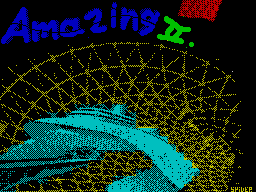|
Amazing #02
14 июля 1998 |
|
User'am - Risc processor - the path to the future.

(C) 1998 by Spider
Music by Andrew Fer
RISC-WAY TO THE FUTURE
ACT 20/80
Appeared in the early seventies
microprocessors, but rather designed to
the basis of their computers, did not seem to be able to
compete with the professional computing devices. Indeed, the 8
- bit micro-computer with a microprocessor 8080, Z-80 or 6502
(Apple, TRS-80, Vic20 i.t.p) could not make any competition or
more computers, which manufactured by IBM, CDC, or Burrought,
nor 16 - bit minicomputers.
Packard DEC, Data General and HewlettPackard. Picture began
to change with the advent of 16-bit microprocessors INTEL 8086
and 32-bit Motorola 68000. Personal computers that use these
microprocessors (IBM PC and Apple
Macintosh), is quite able to compete
to large computers about a decade ago.
On the first day of a microprocessor
constantly were searching for ways to enhance their
performance. Improved
technology has increased the number of
transistors on a chip, and their density
location, the clock speed and efficiency of instruction.
Developed an optimal system commands. And in this directions
promotion was the most significant.
Initially it was thought that the richer the command system,
the more effective working computer. Advertisement
microprocessors were exactly this way. Each team in the
Interpretation spawned the performance of many
(Sometimes tens or even hundreds) of elementary
microinstructions. Therefore, most of the time,
required to develop a new
microprocessor, was spent on debugging microinstructions. And,
as a rule, even in serial specimens of microprocessors early or
later to identify those or other errors. Recall that the error
microcode processor INTEL 80386 and 80486 have been removed
only after more than a year after their appearance on the
market.
Microprocessors traditional architecture
(Firms INTEL, Motorola, National
Semiconductors, Zilog) were named
CISC (Complicated Instuction Computer using a complex set of
commands.)
Intensive testing of the various
processors in the performance and a variety of
tasks carried out by many developers
computers, showed that the processors
very well applicable law, which stated as follows: "20 percent
of the population drinks, 80 percent of beer. "In our case,
this means that mostly in the calculations computers" grind
"are one and the same instructions from a small subset of the
complete system of commands. In the first turn this team reads
and writes to memory and the transition team. Therefore, to
accelerate works naturally to optimize the performance of these
particular teams. As for other, more complex and rarely used,
then the majority can opt out.
ALL JUST genius
Microprocessors are the new architecture were called RISC
(Reduced Instruction Computer-PC with a reduced to a minimum
set of commands). It made special measures to accelerate the
execution of these few commands. Technology development of
microprocessors, computers their basis and mathematical software
for them, became known as RISC-technology.
What the team needed, and what
You can (and should) be sacrificed for the sake of speed? The
answer is obvious: if by reducing the number of commands
"challenging" command (eg "add a constant to the contents of
memory") will be possible to replace a sequence of simpler
("load the contents of the memory cell in the register, "" add
a constant to the contents of the register ") which are faster,
then this "Sophisticated" command can be successfully
excluded in the first "reduction"
As for the commands to access memory. In the RISC
-Processors are typically used
Only teams memory-register transfers and
register memory. All arithmetic and logical operations and
conversions are carried out only with data located in registers.
In 1975 the architect supercomputer CDC and the creator of the
most productive in the world of computers Cray American
engineer Seymour Cray, said: "The registers do machine
instructions are very simple. This is something unique. Most
machines use command system with a much larger variety of
methods of addressing memory than those that I developed. In my
opinion, true path is prostota.Ya entirely for simplicity.
If the command system is too complicated, I did
just do not understand. "
Thus, the ideological foundation RISC-Technology was founded
in the mid seventies. The first true RISC-PC was
created in 1979 by IBM. This 32razryadny computer, called
IBM 801, was built on chips ECL,
had 32 registers, instruction set, most of which was executed
in one machine tact.
The term RISC was first proposed
Professor David Patterson, in his lectures on microprocessor
technology, delivered in 1980 GV University of California at
Berkeley. There was also initiated the development of the
processor RISC I, which was completed in 1982 Two years later
appeared processor RISC II. His main
Features: 32 bit word length, number of registers 138, clock
frequency, 3 MHz. Even without special compilers, performance
of the new microprocessor with perform operations with whole
numbers to be higher than that of the widespread
super-minicomputer VAX 11/780
Shortly after beginning work at Berkeley,
Stanford University team led by John Hennessy
started to develop the project, known as MIPS (Miroprocessor
without Interlocked Pipeline Stages-microprocessor pipelines
without delay, while at the same time, the MIPS acronym stands
for "million instructions per second). Stanford MIPS
was a 32-bit microprocessor with 16 registers and a clock
frequency of 2 MHz. This processor family was the basis of
commercial RISC-processor, manufactured by the same name-MIPS.
Processors with a RISC-architecture produced
and other firms: Ridge, Pyramid, HewlettPackard. A special
place (both from a technical and economic point of view) among
They took the family of microprocessors
SPARC (Scalable Processor Architecture Processor
ARChitecturemasshtabiruemaya) developed by Sun Microsystem. On
example of this particular family of microprocessors we will
introduce in more detail the architecture of RISC.
to be continued ...
Other articles:
Similar articles:
В этот день... 30 December